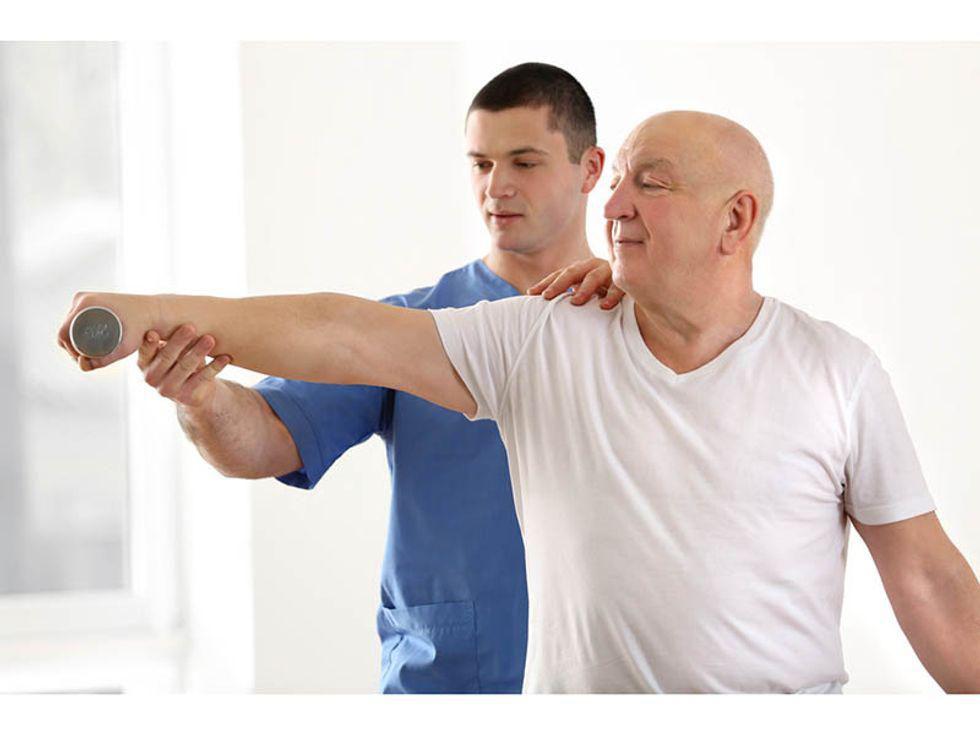
Losing the use of an arm after a stroke can be devastating, but new research could offer survivors fresh hope.
The study found that a combination of targeted brain stimulation therapy, along with intense physical rehabilitation, can restore control of an affected arm or hand.
“This is the first time that brain stimulation combined with rehabilitation therapy for stroke is available outside of a clinical trial,” noted study lead author Teresa Kimberley. “It could set the stage for even more advancements in recovery from other impairments beyond the arm. This is a watershed moment for rehabilitation science.”
Kimberley is a professor of rehabilitation science and physical therapy at the MGH Institute of Health Professions in Boston. Her team’s findings will be presented at next week’s International Stroke Conference in Phoenix.
As a stroke attacks the brain, vital neural pathways connecting the brain to the limbs can be damaged, triggering a loss of function.
Re-establishing those connections can be tough, Kimberley’s team reports.
“The recovery of arm and hand function after a stroke often stalls or even declines, leaving many patients with chronic motor deficits that limit their independence and quality of life,” she said in an American Stroke Association news release. “New treatments that can boost the benefits of physical rehabilitation are desperately needed.”
The new study involved an implanted device that produces stimulation to the vagus nerves, a pair of which run from the brain, down the neck and then to the chest and stomach.
In 2021, the U.S. Food and Drug Administration approved the vagus nerve device to treat deficits in arm function after a stroke.
A total of 74 patients were assessed in the new trial. All were between 22 and 80 years of age and had suffered a stroke anywhere from nine months to 10 years prior to the trial. All had problems with hand or arm movement caused by the stroke.
Patients first completed a six-week intense, in-clinic rehab program as they used the implanted vagus nerve stimulator device. However, only half of the patients had the real device implanted, while the other had a “sham” device implanted.
While the real device emitted continuous vagus nerve stimulation, the fake one emitted just a few pulses thought to be ineffectual, the team said.
After the six-week program, all patients continued with three months of at-home exercise, still using the implants. Folks who’d gotten the real device continued the home exercise for a full year.
Those people who had gotten the fake device during the six-week program were also implanted with the real stimulator afterwards, plus they also engaged in a year of the home exercise program.
The one-year results: Based on standard measurements, people who’d gotten vagus nerve stimulation therapy had two to three times the improvements in hand/arm function, compared to people who got the physical rehab alone, Kimberley’s team reported.
“The pairing of rehabilitation therapy with vagus nerve stimulation likely helps the brain strengthen new neural pathways — like building a bridge to bypass a damaged area,” she explained.
“These long-term, pivotal results mirror our long-term results from an earlier pilot study where we found that patients continue to improve or maintain their gains up to three years after starting vagus nerve stimulation therapy paired with rehabilitation,” Kimberley added. “As a clinician, it is surprising to see someone with chronic stroke — stroke that in many ways is a progressive disease — continue to improve and not show a decline.”
She said it’s important for stroke survivors to not give up on hope of recovery.
“Often after a stroke, people don’t seek additional treatment, thinking that their current impairments are permanent. This is not true! Paired vagus nerve stimulation opens a new avenue and new hope for these patients,” Kimberley said. “I’m also excited about future research that will investigate vagus nerve stimulation paired with rehabilitation for other conditions, such as gait and speech impairments after stroke.”
Because these findings were presented at a medical meeting, they should be considered preliminary until published in a peer-reviewed journal.
More information
There’s more on stroke rehab at the Mayo Clinic.
SOURCE: American Heart Association, news release, Feb. 1, 2024
Source: HealthDay

Leave a Reply